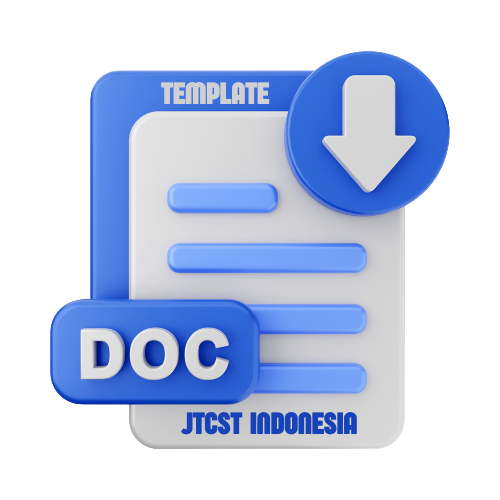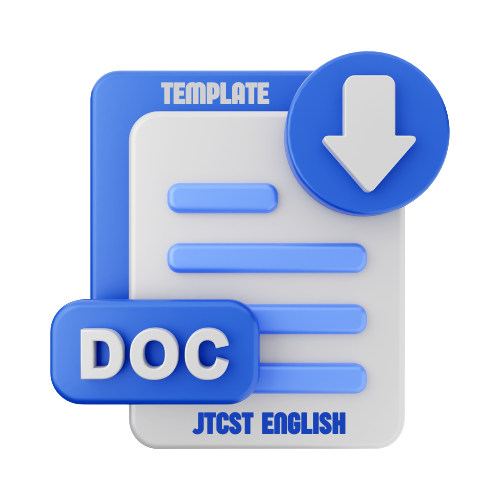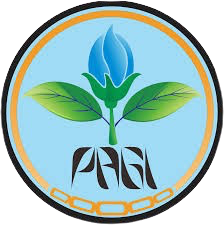| ..:: Quick Menu ::.. |
| Aim and Scope |
| Editorial Team |
| Reviewers |
| Publication Ethic |
| Abstracting/indexing |
| Guideline for Author |
| Screening for Plagiarism |
| Open Access Policy |
| Index Information |
| Copyright Notice |
Guidelines for Author
Please read the JTCST guidelines and follow these instructions carefully. Manuscripts that do not comply with the instructions will be returned for revision without review. The Editor-in-Chief reserves the right to return manuscripts that are not prepared in accordance with these guidelines.
Authors must submit articles through online submission.
Submission Stage
All articles submitted to the JTCST, Full text must be written in good English. Papers must be submitted by authors through online submission.
All manuscripts must describe original research that has not been reported or submitted elsewhere.
After Acceptance
A Manuscript Editor will be assigned to work on the editing stage of the manuscript intended to improve the flow, clarity, grammar, word choice, and format of the article.
We kindly request authors to provide proofreading corrections to the manuscript within three days. The proofreading of the manuscript must be corrected immediately and returned to the Editor. The corresponding author will receive an email with a link to our online manuscript review system.
Submission Declaration and Verification
The submission of an article implies that the work described has not been previously published (except in abstract form or as part of a published academic lecture or thesis or as an electronic preprint), that the work is not under consideration for publication elsewhere. Authors agree that the manuscript will not be published elsewhere in the same form, in English or any other language, including electronically without the prior written consent of the copyright holder.
Privacy Statement
The names and email addresses entered in this journal site will be used exclusively for the purposes stated in this journal and will not be made available for any other purpose or to any other party.
Online Submission Guide
The author must first register as an Author through the register menu. The author must fill in the form as detailed as possible, where the form marked with an asterisk must be filled in. After the form is filled in, the Author clicks the “Register” button to continue the registration. Thus, the Author is taken to the online author submission display, where the Author must click “New Submission”.
Step 1 – Start: The Author must fill in the existing form. Section selection: Article, Front Matter, Back Matter. Fill in the submissions requirement. Submit as author. Agree to copyright. Then click save and continue.
Step 2 – Upload Submission: Upload the registered manuscript. Then select the file format: full paper. Then click save and continue.
Step 3 – Entering Metadata: In this step, the author's manuscript must be entered including the author concerned. After that, the title of the manuscript and abstract must be uploaded by copying the text and pasting it in the text box including keywords.
Step 4 – Confirmation: Your submission has been uploaded and is ready to be sent. You may go back to review and adjust any of the information you have entered before continuing. When you are ready, click "Finish Submission".
This guide describes how to prepare manuscripts prior to online submission. We recommend to all of the authors read this guidelines if you have not previously submiited a paper to JTCST.
The main format of JTCST is original reports which has not been reported or submitted in other previous scientific publication systems. Manuscripts should be written in English or Bahasa Indonesia and is provided with English version of Abstract for those who submitted in Bahasa Indonesia. All submissions are facilitated using online system at: http://ejournal.umm.ac.id/index.php/jtcst/user. All submissions will be reviewed by one of the editors and at least two reviewers with related majors. Tropika considers blind reviewing system, in which the identities of authors and reviewers are kept confidential (see author guidelines in details).
The manuscript should consist of: Title page, Abstract, Keywords, Introduction, Material And Methods, Result and Discussion, Conclusion, Acknowledgment, if any, and References (see Manuscript Format in details). Where appropriate result and discussion may be combined.
JTCST, Journal of tropical science and technology, is a proper channel for publication of papers in plant sciences, agronomy, horticultural, plant breeding, soil-plant sciences, pest or disease-plant sciences and tecnology. Manuscripts reporting experimentation or research in field crops will be accepted for review as papers.
GUIDING PRINCIPLES
An acceptable manuscript will meet the following general criteria: it reports a worthwhile contribution to science, sound methodology was used and is explained with sufficient detail so that other capable scientists could repeat the experiments. Conclusions are supported by data, manuscripts is concise, well written, and understandable.
MANUSCRIPT FORMAT
Manuscript should be uploaded to JTCST journal system and arranged in JTCST standard format, Title, Authors, Address and Email, Abstract, Keywords, Introduction, Materials and Methods, Result and Discussion, Conclusion, Acknowledgment and References. Typed at one side of white paper of A4 size, in single column, 1.5 space line, 10 point Arial font and should be given line numbers. Margins on all four sides are 2 cm.
MANUSCRIPT TITLE
The title of the paper should be concise and informative. Avoid abbreviations and formula where possible. It should be written clearly and concisely describing the contents of the research.
AUTHORS
Manuscript has main author and co authors with full name of the author and co-authors (no abbreviation), includes address (es) and email addresses clearly.
ABSTRACT
The abstract comes after title page in the manuscript. Abstract must be integrated and independent which is consist of introduction and purpose, methods, results, conclusion and suggestion. However the abstract should be written as a single paragraph without these headers. For this reason, References should be avoided. Also, non-standard or uncommon abbreviations should be avoided, but if essential they must be defined at their first mention in the abstract itself. Abstract must be written using 150 until 200 words which has no reference and accompanied keywords.
KEYWORDS
The keywords should be avoiding general and plural terms and multiple concepts. Do not use words or terms in the title as keywords. These keywords will be used for indexing purposes. Keywords should not more than 5 words or phrases in alphabetical order.
INTRODUCTION
State the objectives of the work and provide an adequate background, avoiding a detailed literature survey or a summary of the results. Explain how you addressed the problem and clearly state the aims of your study. As you compose the introduction, think of readers who are not experts in this field. Introduction must be written using 750 until 1000 words
MATERIALS AND METHODS
It should be mention time and place of research in first part. All materials and methods that used such chemical for analysis, treatment and experimental design must be stated clearly and briefly. State the objectives of the work and provide an adequate background, avoiding a detailed literature survey or a summary of the results. A Theory section should extend, not repeat, the background to the article already dealt with in the Introduction and lays the foundation for further work. a Calculation section
represents a practical development from a theoretical basis. Materials and methods must be written using 400 until 600 words.
RESULTS AND DISCUSSION
Result and discussion must be written in the same part. They should be presented continuously start from the main result to the supporting results and equipped with a discussion. Unit of measurement used should follow the prevailing international system. All figures and tables placed separately at the end of manuscript pages and should be active and editable by editor.
CONCLUSION
Conclusion should be explained clearly. Suggestion placed after conclusion contains a recommendation on the research done or an input that can be used directly by consumer. Conclusion and suggestion must be written using 40 until 80 words.
ACKNOWLEDGEMENT
State the grant source and the person to whom the grant was given. Name the person to help you work.
REFERENCES
The author-year notation system is required and completed. All reference mentioned should be written down in reference using American Psychological Association (APA) style and arranged from A to Z. Articles have 10 recent references or over and 80% is journal. The most of references are primary ones (last ten years). Unpublished data and personal communication should not be cited as literature citations. “In Press” articles that have been accepted for publication may be cited in references. Include in the citation the journal in which the “in press” article will appear and the publication date, if a date is available.
Example
Reference to a Journal Publication:
Abdallah, E. H., Musa, Y., Mustafa, M., Sjahril, R., & Riadi, M. (2013). Comparison between hydro- and osmo-priming to determine period needed for priming indicator and its effect on germination percentage of aerobic rice cultivars (Oryza sativa L.). AGRIVITA Journal of Agricultural Science, 38(3), 222-230. http://doi.org/10.17503/agrivita.v38i3.886
Reference to a Book:
Bolda, M. L., Tourte, L., Klonskyk, K. M., & de Moura, R. L. (2005). Sample cost to produce fresh market rasberries. Berkeley, US: University of California Cooperative extension.
Reference to a Chapter in an Edited Book:
Tuong, T. P., & Bouman, B. A. M. (2003). Rice production in water-scarce environments. In W. Kijne, R. Barker, & D. Molden (Eds.), Water productivity in agriculture: Limits and opportunities for improvement (pp. 53–67). Manila, PH: CAB International.
Reference in Proceeding:
Hapsari, L. & Masrum, A. (2011). Diversity and characteristics of banana (Musa acuminata) diploid AA cultivars group collection of Purwodadi botanic garden. In D. Widyatmoko, D. M. Puspitaningtyas, R. Hendrian, Irawati, I. A. Fijridiyanto, J. R. Witono, R. Rosniati, S. R. Ariati, S. Rahayu, & T. Ng Praptosuwiryo (Eds.), Conservation of tropical plants: Current condition and future challenge. Paper presented at Proceedings of Seminar Cibodas Botanic Garden 159th Anniversary, Cibodas (pp. 225-229). Cibodas, ID: Indonesian Institute of Sciences










